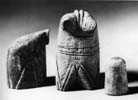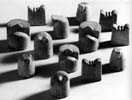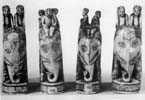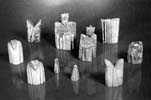References in the notes below to the 'Charlemagne' pieces refer to a group
of pieces traditionaly reputed to have been given to Charlemagne by the calife
of Bagdad, Haroun el Rachid to celebrate his coronation in the year 800. In fact
the pieces date from the end of the 11th century and probably came from Salerne
in Italy.
 |
Bishop. Scandinavian. Walrus tusk. Early 13th Century. The eye holes would
have contained precious stones. Copenhagen, Nationalmuseum. |
 |
Knight, bishop and pawn. Scandinavian early 11th century. Nuremberg,
Germanisches Nationalmuseum. |
 |
Scandinavian pieces in bone. 9th Century. Nuremberg, Germanisches
Nationalmuseum. |
 |
King. One of the 'Charlemagne' pieces.Ivory Italy end of the 11th Century.
Paris Cabinet des médailles. |
 |
Queen. One of the 'Charlemagne' pieces.Ivory Italy end of the 11th Century.
Paris Cabinet des médailles. |
 |
Bishops. From the 'Charlemagne' pieces.Ivory Italy end of the 11th Century.
Paris Cabinet des médailles. |
 |
As above |
 |
Knight. From the 'Charlemagne' pieces.Ivory Italy end of the 11th Century.
Paris Cabinet des médailles. |
 |
Pawn. From the 'Charlemagne' pieces.Ivory Italy end of the 11th Century.
Paris Cabinet des médailles. |
 |
German or scandinavian bone pieces, early 12th century. Noyon Musée
Municipale. |
 |
King. Scandinavian. End of the 12th Century. Sperm whale ivory. Paris Musée
du Louvre. |
 |
Bishop. Scandinavian. End of the 12th Century. Walrus ivory. London British
Museum. |

